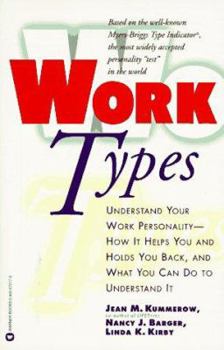Work Types
Select Format
Select Condition 
Book Overview
Applies Myers-Briggs personality types to the workplace, and tells how to improve communications with coworkers of various personality types.
Format:Paperback
Language:English
ISBN:0446672173
ISBN13:9780446672177
Release Date:March 1997
Publisher:Grand Central Publishing
Length:272 Pages
Weight:0.60 lbs.
Dimensions:0.8" x 5.3" x 8.0"
Customer Reviews
3 ratings
Excellent tool for using MBTI theory to address workplace issues.
Published by Thriftbooks.com User , 15 years ago
The is an excellent tool for using Myers-Briggs Type Indicator theory to address typical workplace issues. The book begins with a solid overview of the MBTI and psychological type, with a summary description of each of the sixteen types. The remaining chapters focus on application of MBTI theory in specific work-related challenges: Chapter 2: Communications and Conflict Chapter 3: Time Management Chapter 4: Meetings Chapter 5: Leading / Being in Charge Chapter 6: Teamwork Chapter 7: Exploring another level of type (the importance of balance) Chapter 8: Change Chapter 9: Stress Chapter 10: Making the Most of Your Type at Work The authors begin most chapters with a synopsis of a particularly frustrating conversation or meeting, discuss how different type preferences play into circumstances at hand, and then, revisit the initial conversation or meeting using an understanding of type to help steer things in a more constructive, mutually-satisfying direction. For example, in the chapter on time management, the authors describe a scenario in which an INTJ and an INTP are working together on a project, and the escalating conflict and frustration that results from differing expectations about how to sequence activities and schedule milestones frustrates both. At the end of the chapter, the two individuals are clear about their preferences up front, which leads to enhanced understanding, appropriate expectations on both sides, and reduced frustration. The chapter on meetings is particularly instructive. The authors describe a typical meeting, with the folks who show up late, the wisecrackers, the folks who must stick to the schedule at all costs, the folks who ramble on, the folks who push for a decision, and so forth. At the end of the chapter, the authors rescript the meeting in a more functional way. The authors are very adept at describing and labeling workplace behavior that may be beneficial in some settings yet problematic in others. Behavior is described in such a way that the reader can really understand how seemingly innocuous or well-intended actions may have destructive effects. "T humor" -- witty, sarcastic, often very on-point and funny, is often uncomfortable for those with a feeling preference. The description of the STJ who drones on & on at meetings, providing inappropriate levels of detail, causing others to tune out, is likewise useful. The authors are also very astute about showing the contributions each type makes in the workplace, and clearly articulate how what Ps can do to contribute most effectively in a J-dominated setting, and the like. Each chapter provides insight about and guidance for those of all preferences, and provides detailed, specific guidance on how to apply type in different settings. Overall, this is a most useful guide for anyone wishing to use his or her understanding of type to address workplace issues, for self-improvement, team-building, or coaching others. It would be m
Insightful
Published by Thriftbooks.com User , 15 years ago
I was given this book by a supervisor and found it to be very insightful teaching me ways to deal with challenging co-worker personalities and situations. I since then have purchased several copies for others team members.
User-Friendly Reading
Published by Thriftbooks.com User , 24 years ago
As someone very familiar with the Myers-Briggs Type Indicator, I found WorkTypes to be a very useful tool. As we learn about type in the workplace, it's important to emphasize that type shouldn't limit the kind of work or activities we choose.The explanations "Using Type Knowledge at Work" and "How not to use Type at Work" should be required reading for any employee whose workplace in undergoing restructuring. The preference combinations used narrow down the kind of information shared. An individual who is new to type, and wants to learn more about it on a casual basis, won't be bogged down in temperament or dominant function theories. Scenarios illustrating workplace issues--Leading, Meetings, Change, Communications--are very realistic. Many readers can identify with these situations. The suggestions given to improve these situations are effective and written in a language that is easily converted to actual application. I wish that I had access to this book earlier in my planning process. Since that time, I have recommended the book as part of my workshops. Type notwithstanding, I have also found its applications useful in other environments outside the office.






